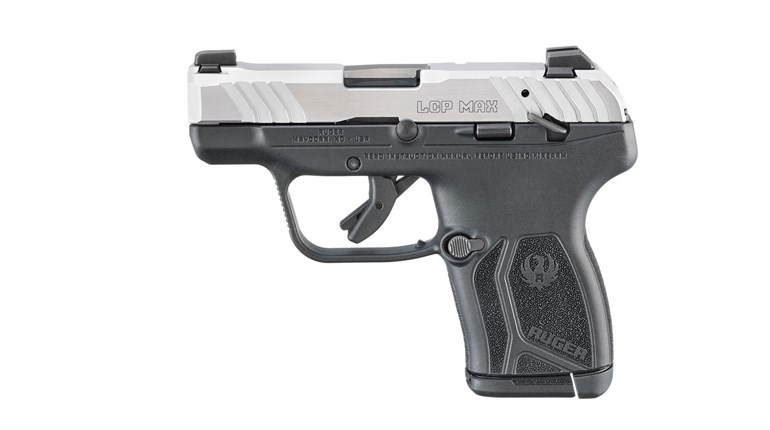** When you buy products through the links on our site, we may earn a commission that supports NRA's mission to protect, preserve and defend the Second Amendment. **

I’ve only been exposed to the word “pico” a couple times in my life. There’s a Pico Boulevard in Los Angeles, where I was raised, and I seem to remember hearing the phrase “pico, pico” years ago in a commercial for salsa. Consequently, I looked up the word in the dictionary and discovered it means one-trillionth of a unit. I have no frame of reference for the size of a trillionth, but I get the marketing inference—Beretta’s new Pico .380 ACP pistol is small.
Intended for the concealed-carry market, the Pico is a tiny, locked-breech, recoil-operated semi-automatic pistol chambered for the revitalized .380 ACP cartridge. Like many of today’s pocket pistols, it has a polymer frame, and a stainless steel barrel and slide. Unlike some of its brethren, however, it is not striker-fired but rather uses a conventional hammer/trigger system in a double-action-only configuration.
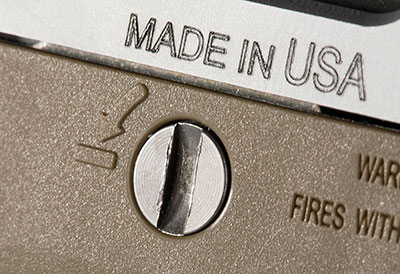 The pistol has re-strike capability, which is interesting, but not universally blessed. Training classes I’ve attended teach the student to immediately initiate the “tap/rack” clearing technique when a trigger pull produces a click instead of a bang. If you’re fighting for your life, several more redundant clicks before you fix the problem could prove costly. That said, the “tap/rack” works just as well on a double-action, conventional-hammer pistol as it does on a striker-fired handgun, and if you’ve trained properly, that training will kick in the instant you hear your gun click or feel it not fire.
The pistol has re-strike capability, which is interesting, but not universally blessed. Training classes I’ve attended teach the student to immediately initiate the “tap/rack” clearing technique when a trigger pull produces a click instead of a bang. If you’re fighting for your life, several more redundant clicks before you fix the problem could prove costly. That said, the “tap/rack” works just as well on a double-action, conventional-hammer pistol as it does on a striker-fired handgun, and if you’ve trained properly, that training will kick in the instant you hear your gun click or feel it not fire.
Other than the double-action-only trigger, the Pico operates and cycles much like John Browning’s 1911. Also like the 1911, there is no magazine-disconnect safety, so you can fire the pistol with the magazine removed. Speaking of magazines, two are furnished with the Pico: One has a flush basepad for maximum concealability, while the other has an extended tab on the magazine base enabling the shooter to get every finger of the shooting hand on the grip. Both magazines are six-round variants and are easy to load. They slide smoothly into the magazine well and lock into place with a positive click.
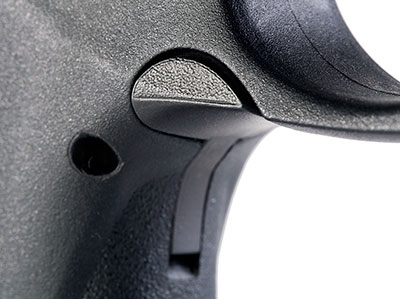 The magazine-release lever on the Pico fits flush into the trigger guard and frame. It is ambidextrous and is operated by pushing downward, rather than into, the grip. Partly due to lack of familiarity and partly due to the strength of the springs, I could not release the magazine using just one finger or the thumb of my shooting hand. I had to put both hands on the gun and push (or pull) downward on both sides of the button simulta-neously to get the magazine to drop free. There is no protrusion of this button from the side of the pistol—it blends into the shape of the trigger guard and frame.
The magazine-release lever on the Pico fits flush into the trigger guard and frame. It is ambidextrous and is operated by pushing downward, rather than into, the grip. Partly due to lack of familiarity and partly due to the strength of the springs, I could not release the magazine using just one finger or the thumb of my shooting hand. I had to put both hands on the gun and push (or pull) downward on both sides of the button simulta-neously to get the magazine to drop free. There is no protrusion of this button from the side of the pistol—it blends into the shape of the trigger guard and frame.
My initial impression was changing the Pico’s magazine was much slower than on other small .380 ACP handguns, except the process is slow on all pistols of this size. The heel of the shooting hand extends below the grip, so no matter how easy it is to hit the release, the magazine remains trapped in place by the hand and is unable to drop free. The mag-change technique for a duty-size pistol won’t work with a pocket .380, whether it’s the Pico or another model.
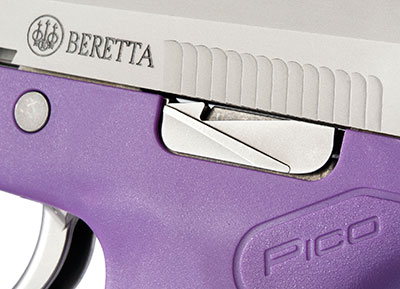 Operating controls on the left side of the Pico’s frame are minimal—there’s a slide-stop lever, and nothing else. The lever automatically locks the slide rearward when the last round in the magazine is fired. It can be used to manually lock the slide open, but not push to release the slide with an empty magazine in the pistol. If you remove the magazine and then pull the slide slightly rearward, however, the lever retracts and the slide will close. Likewise, if you insert a loaded magazine with the slide locked to the rear and then move the slide rearward, the lever also retracts, releasing the slide to go forward, pick up a round from the magazine and move into battery. The lever protrudes only slightly from the slide and frame, which keeps the tiny handgun’s width less than .75 inch wide. Neither does the take-down bolt protrude from the sides of the frame, but it must be rotated by a screwdriver to initiate disassembly.
Operating controls on the left side of the Pico’s frame are minimal—there’s a slide-stop lever, and nothing else. The lever automatically locks the slide rearward when the last round in the magazine is fired. It can be used to manually lock the slide open, but not push to release the slide with an empty magazine in the pistol. If you remove the magazine and then pull the slide slightly rearward, however, the lever retracts and the slide will close. Likewise, if you insert a loaded magazine with the slide locked to the rear and then move the slide rearward, the lever also retracts, releasing the slide to go forward, pick up a round from the magazine and move into battery. The lever protrudes only slightly from the slide and frame, which keeps the tiny handgun’s width less than .75 inch wide. Neither does the take-down bolt protrude from the sides of the frame, but it must be rotated by a screwdriver to initiate disassembly.
The Pico has a long, external extractor that remains almost flush with the slide’s surface, even with a round in the chamber. It’s not a loaded-chamber indicator, since it is very difficult to see or feel when the gun is loaded. The .25-inch serrations on the slide just below the extractor will help you perform a chamber check. Keep in mind that for a pocket pistol, the conveniences of a service sidearm give way to ease of concealment, and Beretta has made some good decisions regarding this trade-off in the Pico.
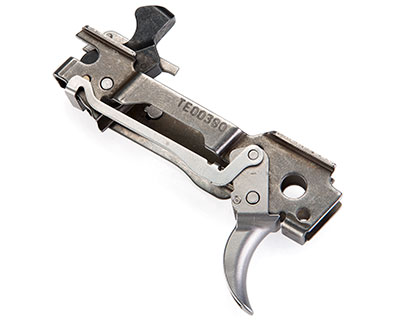 Perhaps the Pico’s best attribute—apart from its small size—is the set of Trijicon sights on the model I tested. At first glance, the sights appear to be unsightly bumps in the pistol’s compact appearance, but that’s slightly misleading. With the flat-base magazine installed, the height of the gun measured to the top of the rear sight is only 4 inches. Perhaps 1⁄16 inch of that might have been shaved from the overall height by going with less-visible sights, but I’ll gladly trade that minimal increase in height for the capability of seeing my sights and hitting my target in low light or near darkness. Pico models without the Trijicon units installed still have excellent sights for such a small pistol.
Perhaps the Pico’s best attribute—apart from its small size—is the set of Trijicon sights on the model I tested. At first glance, the sights appear to be unsightly bumps in the pistol’s compact appearance, but that’s slightly misleading. With the flat-base magazine installed, the height of the gun measured to the top of the rear sight is only 4 inches. Perhaps 1⁄16 inch of that might have been shaved from the overall height by going with less-visible sights, but I’ll gladly trade that minimal increase in height for the capability of seeing my sights and hitting my target in low light or near darkness. Pico models without the Trijicon units installed still have excellent sights for such a small pistol.
Should you prefer different sights, Beretta has made it easy to change them. Both the front and rear sights are mounted in dovetail slots—the rear in a lateral cut, the front in a longitudinal slot—and both are held in place with a hex screw. I do have a problem with the front-sight dovetail slot being longitudinal rather than lateral. The setscrew loosened from vibration during testing, and the front sight simply flew off the muzzle end of the handgun and was lost. Run that cut sideways, and the shooter will have some warning in the event the sight blade comes loose. It will drift left or right, but will be retained by the shape of the slot. When your rounds start hitting a couple of feet left or right of your point of aim, you will have a clue to check the sights.
Beretta engineers have gone to great lengths to ensure the Pico’s design is modular. It begins with a steel subchassis, which is the “firearm” as far as the government is concerned and therefore bears the serial number. Because all other parts—like barrels, slides and grip frames—attach to the subchassis, the buyer can switch or replace any other part of the pistol without having to go through an FFL dealer or worry about legal concerns. Beretta currently offers a .32 ACP barrel, which is all you need to swap chamberings. Moreover, the company offers a frame with an integrated LaserMax laser or white-light unit. Incorporating these accessories into the frame ensures the pistol is smaller and more concealed-carry friendly than it would if you were to bolt on aftermarket accessories. In addition, different colors of frames are available for those who want something different than regular old black and stainless, including pink, purple, white and OD green.
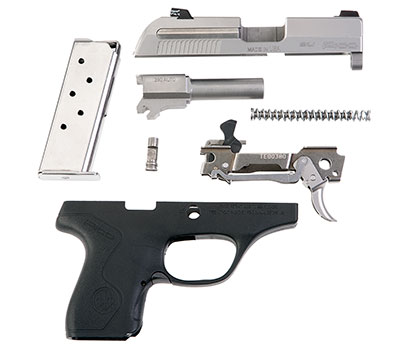 For most people, finding a handgun that fits properly is like Goldilocks searching through the three bears’ house—everything is always too extreme in one direction or the other. Pocket pistols are usually too small for the average human hand, so I was surprised when I found the Pico fit me reasonably well. In truth, I think the excellent sights made the handgun much more effective than I was used to from a tiny .380 ACP. While the grip is extremely small, ergonomics and pointing characteristics are good. The backstrap and tiny frontstrap are slightly textured, but more than enough to handle the minimal recoil of the .380 ACP cartridge. As expected, the pistol was easier to shoot with the longer magazine in place than with the flush baseplate. The larger magazine does add an inch to the overall height of the pistol and extends that dimension more than an inch beyond a Galco PRO 436 pocket holster. With the longer magazine, the holstered pistol would only fit in the pockets of my “tactical” trousers, which limits wardrobe selection when pocket carrying.
For most people, finding a handgun that fits properly is like Goldilocks searching through the three bears’ house—everything is always too extreme in one direction or the other. Pocket pistols are usually too small for the average human hand, so I was surprised when I found the Pico fit me reasonably well. In truth, I think the excellent sights made the handgun much more effective than I was used to from a tiny .380 ACP. While the grip is extremely small, ergonomics and pointing characteristics are good. The backstrap and tiny frontstrap are slightly textured, but more than enough to handle the minimal recoil of the .380 ACP cartridge. As expected, the pistol was easier to shoot with the longer magazine in place than with the flush baseplate. The larger magazine does add an inch to the overall height of the pistol and extends that dimension more than an inch beyond a Galco PRO 436 pocket holster. With the longer magazine, the holstered pistol would only fit in the pockets of my “tactical” trousers, which limits wardrobe selection when pocket carrying.
Accuracy testing the Pico was challenging. The little pistol’s solid ergonomics and excellent sights were offset by a long, heavy trigger pull. Even resting my forearms on a bag, trying to hold the gun rock-steady through the full length of the trigger pull was more difficult than simply achieving a quick sight picture shooting offhand and pressing the trigger. While groups at 10 yards averaged 2 to 3 inches with all tested loads, shooting the Pico required enormous concentration. Keep in mind, however, the mission of a pocket pistol is not to shoot sub-MOA groups—it’s to get on target quickly and resolve close-range, life-threatening situations. I found it relatively easy to put multiple rounds into the chest area of a silhouette target at close range.
All tiny pistols are more difficult to shoot than their full-size counterparts. They are designed for easy concealment and carry comfort. Beretta has designed the Pico to fulfill that mission, and its modularity makes it a very attractive choice for a handgun you can carry every day.
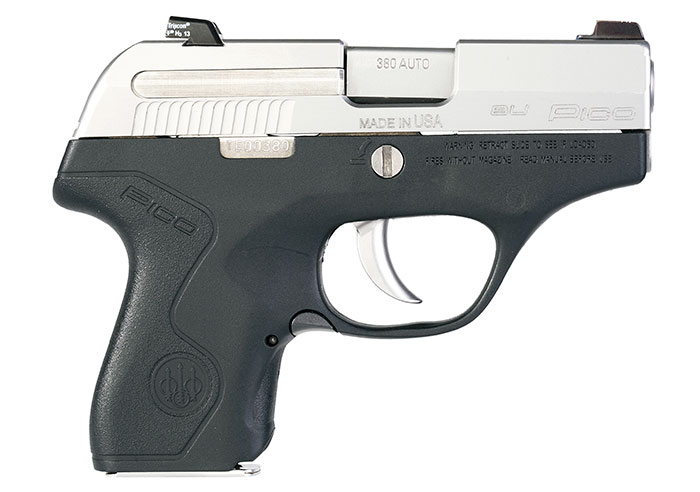
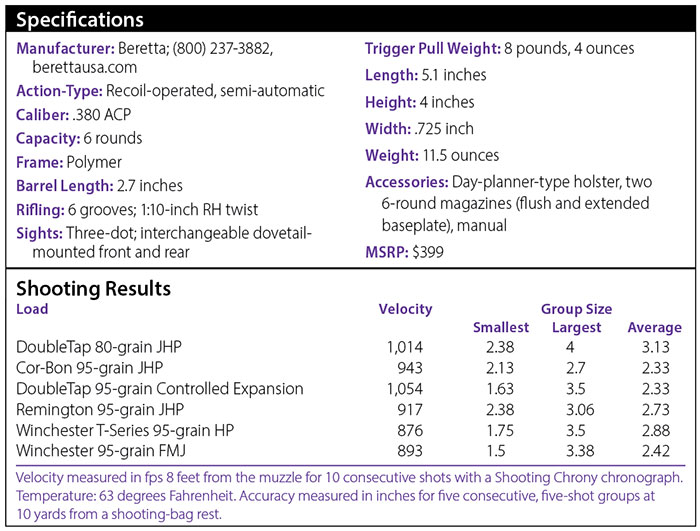
Intended for the concealed-carry market, the Pico is a tiny, locked-breech, recoil-operated semi-automatic pistol chambered for the revitalized .380 ACP cartridge. Like many of today’s pocket pistols, it has a polymer frame, and a stainless steel barrel and slide. Unlike some of its brethren, however, it is not striker-fired but rather uses a conventional hammer/trigger system in a double-action-only configuration.

A standard, slotted screwdriver or a cartridge rim is needed to remove the takedown pin and disassemble the Pico.
Other than the double-action-only trigger, the Pico operates and cycles much like John Browning’s 1911. Also like the 1911, there is no magazine-disconnect safety, so you can fire the pistol with the magazine removed. Speaking of magazines, two are furnished with the Pico: One has a flush basepad for maximum concealability, while the other has an extended tab on the magazine base enabling the shooter to get every finger of the shooting hand on the grip. Both magazines are six-round variants and are easy to load. They slide smoothly into the magazine well and lock into place with a positive click.

Removing the magazine requires finding the sculpted release lever on the side of the frame.
My initial impression was changing the Pico’s magazine was much slower than on other small .380 ACP handguns, except the process is slow on all pistols of this size. The heel of the shooting hand extends below the grip, so no matter how easy it is to hit the release, the magazine remains trapped in place by the hand and is unable to drop free. The mag-change technique for a duty-size pistol won’t work with a pocket .380, whether it’s the Pico or another model.

Evoking the P38 can opener, the slide release extends only the tiniest fraction outside the frame for maximum concealment.
The Pico has a long, external extractor that remains almost flush with the slide’s surface, even with a round in the chamber. It’s not a loaded-chamber indicator, since it is very difficult to see or feel when the gun is loaded. The .25-inch serrations on the slide just below the extractor will help you perform a chamber check. Keep in mind that for a pocket pistol, the conveniences of a service sidearm give way to ease of concealment, and Beretta has made some good decisions regarding this trade-off in the Pico.

The subchassis is removable and comprises the actual firearm. It allows the user to change frames and even chamberings with ease.
Should you prefer different sights, Beretta has made it easy to change them. Both the front and rear sights are mounted in dovetail slots—the rear in a lateral cut, the front in a longitudinal slot—and both are held in place with a hex screw. I do have a problem with the front-sight dovetail slot being longitudinal rather than lateral. The setscrew loosened from vibration during testing, and the front sight simply flew off the muzzle end of the handgun and was lost. Run that cut sideways, and the shooter will have some warning in the event the sight blade comes loose. It will drift left or right, but will be retained by the shape of the slot. When your rounds start hitting a couple of feet left or right of your point of aim, you will have a clue to check the sights.
Beretta engineers have gone to great lengths to ensure the Pico’s design is modular. It begins with a steel subchassis, which is the “firearm” as far as the government is concerned and therefore bears the serial number. Because all other parts—like barrels, slides and grip frames—attach to the subchassis, the buyer can switch or replace any other part of the pistol without having to go through an FFL dealer or worry about legal concerns. Beretta currently offers a .32 ACP barrel, which is all you need to swap chamberings. Moreover, the company offers a frame with an integrated LaserMax laser or white-light unit. Incorporating these accessories into the frame ensures the pistol is smaller and more concealed-carry friendly than it would if you were to bolt on aftermarket accessories. In addition, different colors of frames are available for those who want something different than regular old black and stainless, including pink, purple, white and OD green.

null
Accuracy testing the Pico was challenging. The little pistol’s solid ergonomics and excellent sights were offset by a long, heavy trigger pull. Even resting my forearms on a bag, trying to hold the gun rock-steady through the full length of the trigger pull was more difficult than simply achieving a quick sight picture shooting offhand and pressing the trigger. While groups at 10 yards averaged 2 to 3 inches with all tested loads, shooting the Pico required enormous concentration. Keep in mind, however, the mission of a pocket pistol is not to shoot sub-MOA groups—it’s to get on target quickly and resolve close-range, life-threatening situations. I found it relatively easy to put multiple rounds into the chest area of a silhouette target at close range.
All tiny pistols are more difficult to shoot than their full-size counterparts. They are designed for easy concealment and carry comfort. Beretta has designed the Pico to fulfill that mission, and its modularity makes it a very attractive choice for a handgun you can carry every day.

















